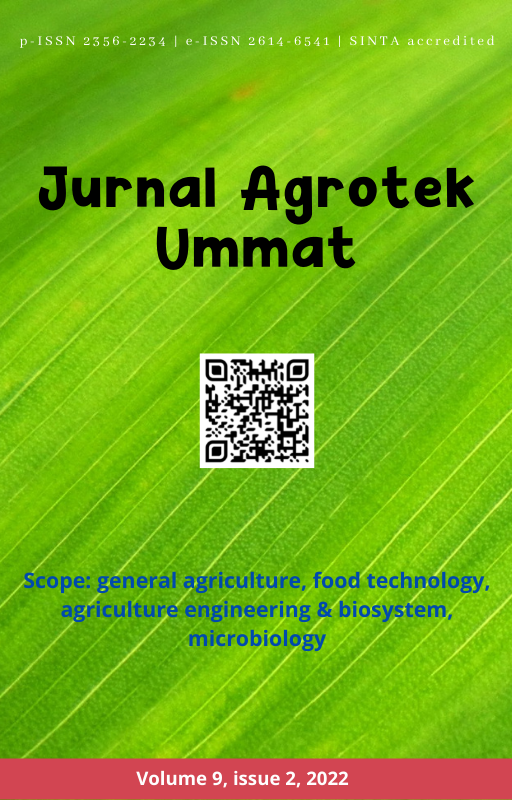The influence of socio-economic factors on tobacco farmers' income (case study in Suralaga District, East Lombok Regency)
DOI:
https://doi.org/10.31764/jau.v9i2.8300Keywords:
farming, income, regression analysis, socio-economic, tobaccoAbstract
Tobacco is a commercial commodity with high economic value. The tobacco producing industry has a considerable contribution in state revenues, employment and the source of farmer income. The purpose of this study was for; 1) explain the characteristics of tobacco farming; 2) Analyzing the influence of socio-economic factors on farmer income. The research was conducted in Suralaga District, East Lombok Regency. The sampling technique used was purposive sampling as many as 30 farmer respondents who carry out tobacco farming. The data analysis method used in this study was quantitative analysis with multiple linear regression approaches. The results of the analysis show the socio-economic factors that influence the income of tobacco farmers is the factor of the amount of production (X1), the value of land lease (X2), the value of fertilizer use (X4), the value of the use of agricultural medicine (X5), labor costs (X6 ), and the selling price of tobacco (X7).References
Amalina, A. N., Darsono, & Farichani, M. (2020). Analisis Efisiensi Penggunaan Input Produksi Pada Usahatani Tembakau di Kecamatan Eromoko, Kabupaten Wonogiri. AGRISTA, 8(3), 110–121.
Amalina, A. N., Darsono, & Ferichani, M. (2014). Analisis Efisiensi Penggunaan Input Produksi Pada Usahatani Tembakau di Kecamatan Eromoko, Kabupaten Wonogiri. AGRISTA, 8(3), 110–121.
Anley, Y., Bogale, A., & Haile-Gabriel, A. (2007). Adoption decision and use intensity of soil and water conservation measures by smallholder subsistence farmers in Dedo District, Western Ethiopia. Land Degradation & Development, 18(3), 289–302. https://doi.org/10.1002/ldr.775
BPS. (2019). Data Sosial dan Kependudukan Indonesia. Retrieved from https://www.bps.go.id/subject/12/kependudukan.html
Gapari, M. Z. (2020). Analisis Kondisi Sosial Ekonomi Rumah Tangga Petani Tembakau di Desa Batu Nampar Kecamatan Jerowaru. Islamika, 2(1), 20–35. https://doi.org/10.36088/islamika.v2i1.427
Halifa, N., Ekawati, I., & Adi, I. J. (2007). Pengaruh Faktor-Faktor Produksi Terhadap Pendapatan Usahatani Tembakau Gunung. Jurnal Cemara, 4(1), 18–21. Retrieved from http://journal.unipdu.ac.id:8080/index.php/seminas/article/view/192
Herminingsih, H., & Rokhani. (2014). Pengaruh perubahan iklim terhadap perilaku petani tembakau di kabupaten jember. Jurnal Matematika, Saint, Teknologi, 15(1), 42–51.
Kasri, R. A. (2011). Time series evidence on education and economic growth in Indonesia. Economic Journal of Emerging Markets, 3(2), 109–123.
Kementerian Perindustrian. (2017). Kontribusi Besar Industri Hasil Tembakau Bagi Ekonomi Nasional. Retrieved from https://kemenperin.go.id/artikel/17257/Kontribusi-Besar-Industri-Hasil-Tembakau-Bagi-Ekonomi-Nasional
Lutfi, M., & Baladina, N. (2018). Analisis Efisiensi Teknis Penggunaan Faktor Produksi Pertanian pada Usahatani Tembakau. Jurnal Ekonomi Pertanian Dan Agribisnis (JEPA), 2(3), 226–233.
Nazam, M., Suriadi, A., & Sahram. (2014). Analisis Ekonomi Usaha Tani Tembakau Virginia dan Permasalahannya di Nusa Tenggara Barat (Kasus di Kabupaten Lombok Timur). Semiloka Nasional Tanaman Pemanis,Serat, Tembakau, Dan Minyak Industri Pusat Penelitian Dan Pengembangan Perkebunan, 179–188.
Nur, Y. H. (Kementerian P., & Salim, Z. (Lembaga I. P. I. (2014). The Competitiveness of Local Virginia Tobacco : a Value Chain Analysis. Jurnal Ekonomi Dan Pembangunan, 22, 1–10.
Nursan, M., Ayu, C., & Komang, P. (2020). Usahatani Tembakau Virginia Di Kabupaten Lombok Tengah. 2748.
Nyanga, P. H., Johnsen, F. H., & Aune, J. B. (2011). Smallholder farmers’ perceptions of climate change and conservation agriculture: evidence from Zambia. Journal of Sustainable Development, 4(4), 73–85.
Romli, M. S., Iswahyudi, N., Ahmad, N., & Ningsih, K. (2019). Model Pengendalian Supply (Penawaran) Tembakau Madura Pada Subsistem Hulu Sebagai Upaya Mendukung Penurunan Tingkat Konsumsi Rokok. Jurnal Hexagro, 3(2), 39–45. https://doi.org/10.36423/hexagro.v3i2.278
Santoso, H. (2018). Analisis Faktor-Faktor Yang Mempengaruhi Pendapatan Usahatani Tembakau (Nicitiana tabacum) Di Desa Konang, Kecamatan Galis, Kabupaten Pamekasan. In Universitas Brawijaya. Retrieved from http://link.springer.com/10.1007/978-3-319-59379-1%0Ahttp://dx.doi.org/10.1016/B978-0-12-420070-8.00002-7%0Ahttp://dx.doi.org/10.1016/j.ab.2015.03.024%0Ahttps://doi.org/10.1080/07352689.2018.1441103%0Ahttp://www.chile.bmw-motorrad.cl/sync/showroom/lam/es/
Septiadi, D. (2016). Dampak Kebijakan Perberasan Terhadap Pengentasan Kemiskinan Di Indonesia. Bogor: IPB.
Septiadi, D., Suparyana, P. K., & FR, A. F. U. (2020). Analisis pendapatan dan pengaruh penggunaan input produksi pada usahatani kedelai di kabupaten lombok tengah. JIA (Jurnal Ilmiah Agribisnis): Jurnal Agribisnis Dan Ilmu Sosial Ekonomi PErtanian, 5(4), 141–149.
Sugiyono. (2011). Metodologi Penelitian Kuantitatif, Kualitatif dan R&D. Bandung: Alfabeta.
Wehantouw, A. D., Manginsela, E. P., & Moniaga, V. R. B. (2018). Faktor Beralihnya Tenaga Kerja Anak Petani Ke Sektor Non-Pertanian di Desa Treman Kecamatan Kaudian Kabupaten Minahasa Utara. Agri-SosioekonomI, 14(2), 1. https://doi.org/10.35791/agrsosek.14.2.2018.20098
Wuryantoro, & Ayu, C. (2020). Kabupaten Lombok Timur Economic Study And Labor Force Absorption On Partnership Tobacco Farm In East Lombok District Jurnal Agrimansion, 21(3), 164–172.
Downloads
Published
Issue
Section
License
Authors who publish articles in Jurnal Agrotek Ummatagree to the following terms:- Authors retain copyright of the article and grant the journal right of first publication with the work simultaneously licensed under a CC-BY-SA or The Creative Commons Attribution–ShareAlike License.
- Authors are able to enter into separate, additional contractual arrangements for the non-exclusive distribution of the journal's published version of the work (e.g., post it to an institutional repository or publish it in a book), with an acknowledgment of its initial publication in this journal.
- Authors are permitted and encouraged to post their work online (e.g., in institutional repositories or on their website) prior to and during the submission process, as it can lead to productive exchanges, as well as earlier and greater citation of published work (See The Effect of Open Access).

